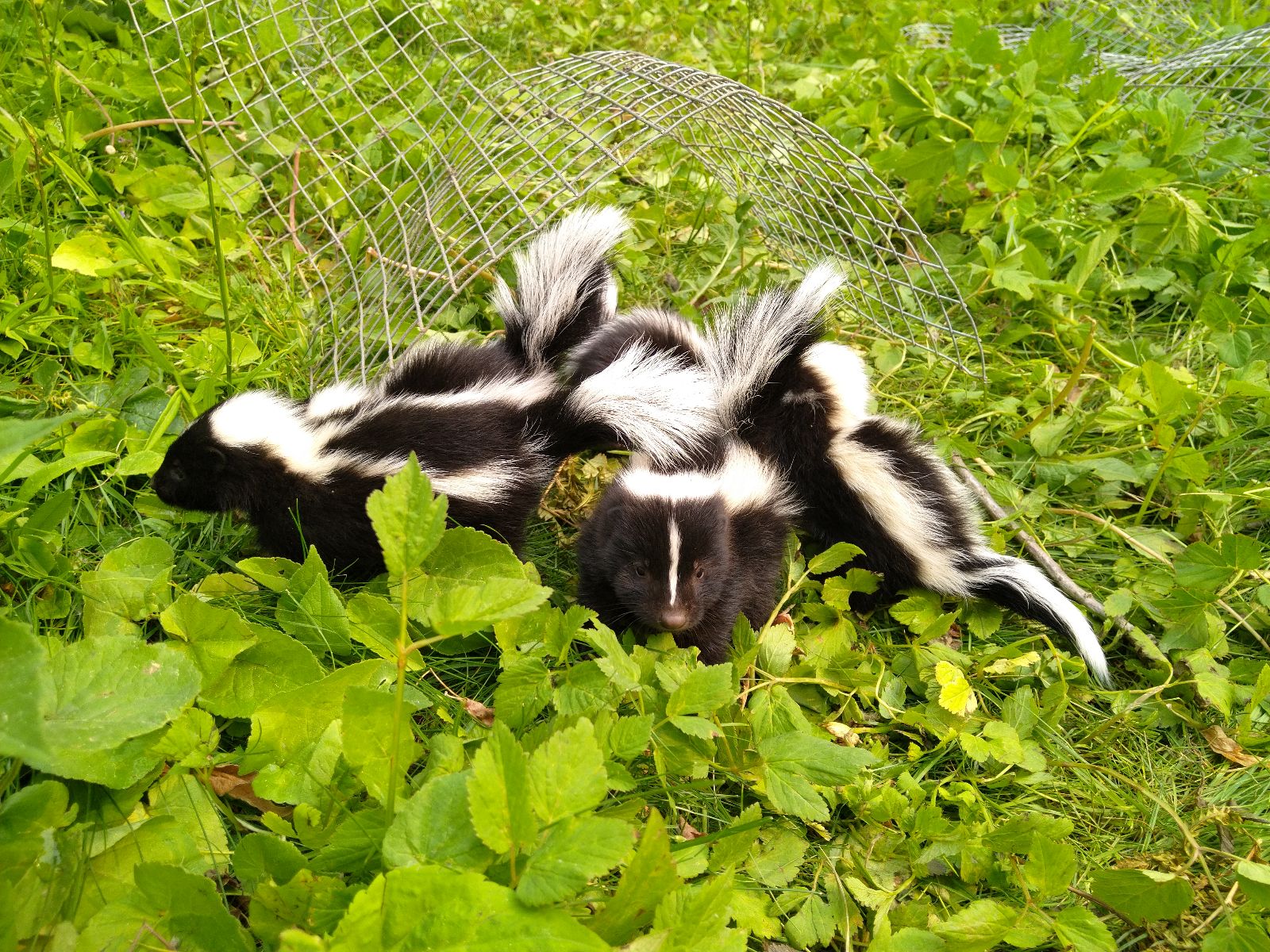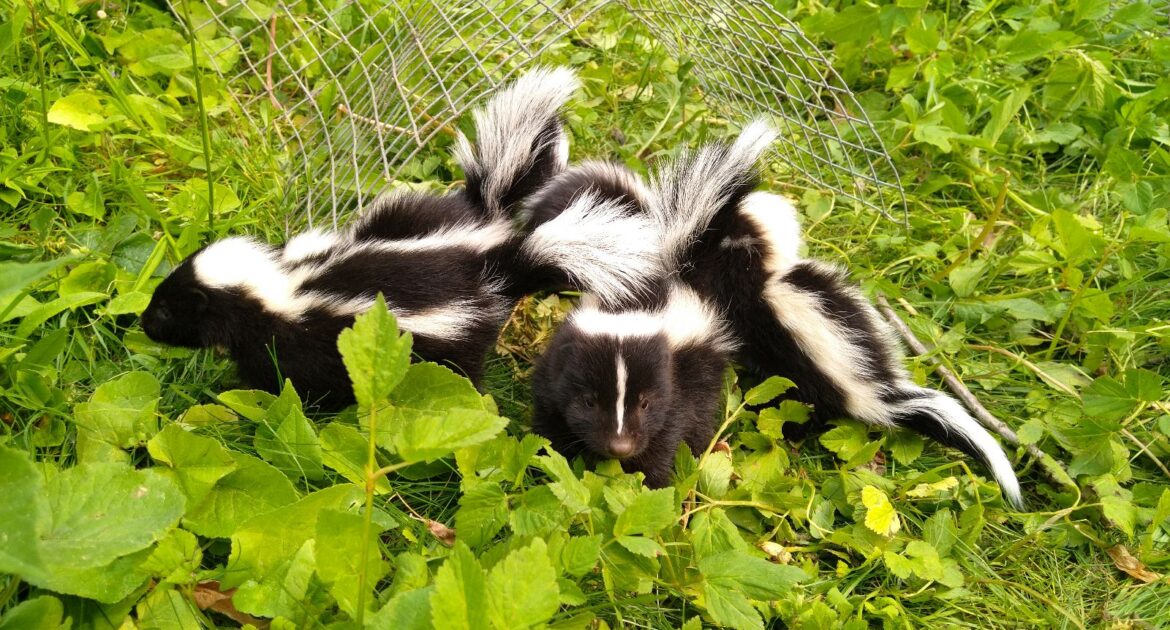If you live in Andover and have a skunk problem, you’re not alone. Skunks are a common sight in suburban areas, especially during the spring and summer months when they’re busy raising their young. While they are mostly harmless animals, they can cause a lot of damage to your property and leave a strong odor behind if they spray. If you’ve noticed them around your property, it’s possible there’s a den nearby.
Skunk removal can be a tricky process, especially if babies are involved. If you’re wondering when the babies leave their den, you’ve come to the right place. In this blog post, our Skedaddle experts provide you with all the information you need to know about wildlife control in Andover and how to get rid of baby skunks without getting sprayed.
Understanding the Life Cycle of Baby Skunks
The life cycle of baby skunks, or kits, begins when they are born, typically in May or June. The kits stay in their den with their mother for approximately six to eight weeks as they develop and mature. During this time in the den, the mother is nurturing her young, teaching them survival skills, how to forage for food, and basically preparing them for the outside world.
It is crucial to note that at around the eight-week mark, the babies start venturing out of their den and exploring their surroundings. This is a vulnerable time for these kits, as they are still developing their defense mechanisms and are more susceptible to predation and human disturbances.
The Transition: From Den to Independence
As wildlife control experts, we often receive calls from worried homeowners who spot baby skunks wandering in their backyards around the mid-summer time. This is the time dubbed the “transition,” and it’s when baby skunks begin to leave their dens to start exploring.
By mid-August, the young start to become independent and can fend for themselves. However, they often stay together and share winter dens, especially in colder regions where winter shelter is required for survival.
Even though the baby skunks are independent around mid-August, they generally don’t completely vacate the den until the fall months, i.e., September or October. This is also when you may notice more activity around your property, as the young skunks are looking for new territories to claim as their own.
What This Means for You and Your Property
Understanding when the babies leave their den can help you manage and potentially avoid conflicts with them. Remember, the intention of wildlife is not to cause harm or damage, they are simply animals trying to survive and find a safe place to live.
As experts in wildlife control, we at Skedaddle highly recommend that you don’t try to remove or trap them on your own, particularly during the baby season. Doing so may lead to unintended harm towards the animals and potentially a defensive spray response.
Recognize the Signs: Indications that Baby Skunks Are Preparing to Leave Their Den
Spotting the signs that the babies are preparing to leave their den puts you a step ahead in preventing possible property damage and unwanted encounters. Among these signs are increased sightings, particularly of smaller skunks, and new digging or foraging marks in your yard.
Increased Sightings
Increased activity around your property is a clear sign that kits are starting to venture out of the den. You may see them foraging for food in your yard or hear them moving around. Most importantly, be vigilant from mid-summer through fall, as this is the time period when the young are exploring and learning their way around.
New Digging or Foraging Marks
Skunks are excellent diggers. They use their sharp claws to dig for insect larvae and grubs, their primary food sources. If you notice fresh digging marks in your yard or garden, it may be a sign that the babies have started to venture out of their nest. Keep a lookout for small cone-shaped holes or turned-over stones, indicative of feeding signs.
Increased Odor
A strong, persistent skunk-like odor may indicate that the babies are in the vicinity and have recently sprayed in response to perceived threats. Remember, juvenile skunks, while still learning to control their spraying, can emit a potent spray when scared or startled.
Preventing Intrusion: Tips from Skedaddle Wildlife Control
As a professional wildlife control service, Skedaddle has pioneered various non-invasive, humane treatment methods, often outperforming traditional measures in effectiveness and sustainability. Our accumulated expertise allows us to offer you invaluable advice on how to prevent them from invading your property.
Seal Potential Entry Points
Skunks are notorious for their ability to exploit small cracks or holes around buildings and other structures. Given their adaptability and resourcefulness, even a small opportunity is sufficient for them to establish their den. Your first preventative measure should therefore be to inspect your property thoroughly and repair any potential entry points. Think of vents, openings in your deck or foundation, and gaps under doors.
Erect A Skunk-Proof Barrier
A physical barrier can work wonders by discouraging them from approaching your property. A solid fence, installed at least 1-2 feet below and above ground, will block them from burrowing underneath or climbing over it. Remember, it’s not just about making your yard physically less accessible, it’s also about discouraging them with the message that your property is not an easy target.
Manage Your Garbage Well
Garbage and compost bins are treasure troves for skunks, providing an easy meal full of variety. To these animals, your garbage might as well be a five-star restaurant. Limit this attraction by storing your bins securely in a locker or shed, or strapping the lids on tight to prevent them from accessing the food inside. It is important to note that, the less appealing your property is food-wise, the less likely they are to stick around.
Maintain a Clean Garden
A clean, well-maintained garden not only adds to the beauty of your property but also helps in deterring them. Regular raking of leaves, nuts, and fruits eliminates food sources, and clearing woodpiles or debris removes potential shelter for skunks. The more inhospitable the environment, the less appealing it will be.
Remember, while these tips can greatly assist in deterring them, wildlife behavior can be unpredictable. In the face of persistent or recurrent skunk intrusion, professional aid might be necessary. Don’t hesitate to reach out to Skedaddle; your safety and peace of mind are our utmost priority.
Call Skedaddle for Wildlife Control in Andover
When it comes to wildlife control, Skedaddle stands out for its humane and ethical practices. Our priority at Skedaddle is always the welfare of the wildlife involved. We understand the importance of treating each animal with respect, and we prioritize non-lethal methods of control. We ensure every animal we handle is relocated safely to its natural habitat without any harm.
Professional, Comprehensive Service
We are not just about eviction, but also about prevention and education. Our professional team offers comprehensive service that goes beyond removing animals from your property – we also provide advice and solutions to prevent future intrusions. By educating our customers about potential skunk attractors, like easily accessible food or shelter, we help them create unsuitable habitats for these animals on their properties.
If you’re serious about your property’s wildlife control, don’t face the challenge alone. Rely on our comprehensive, professional service to not only remove these unwanted guests but to also avoid future issues. We’re more than just a service, we’re your partner in ensuring your property remains yours and yours alone. Call now to schedule an appointment or learn more about our services!




